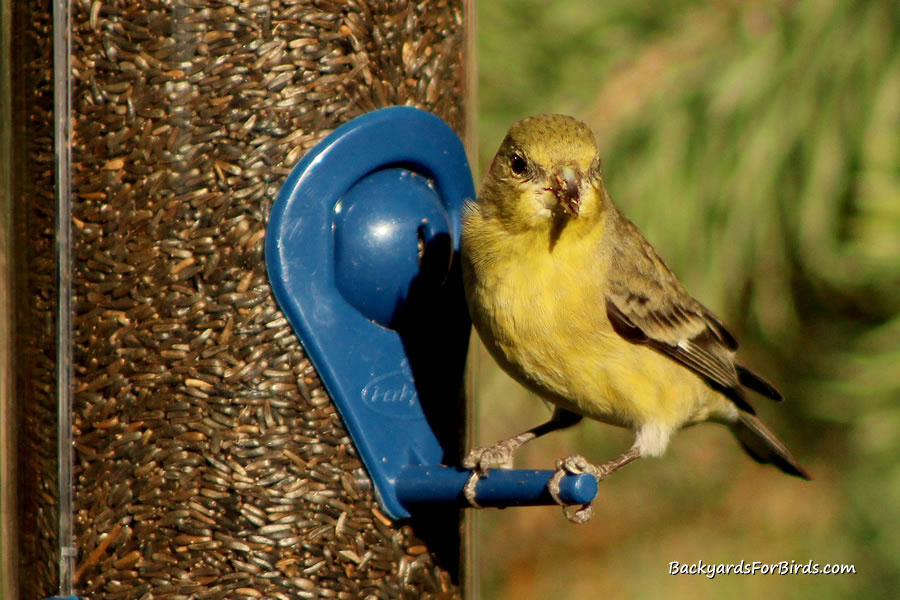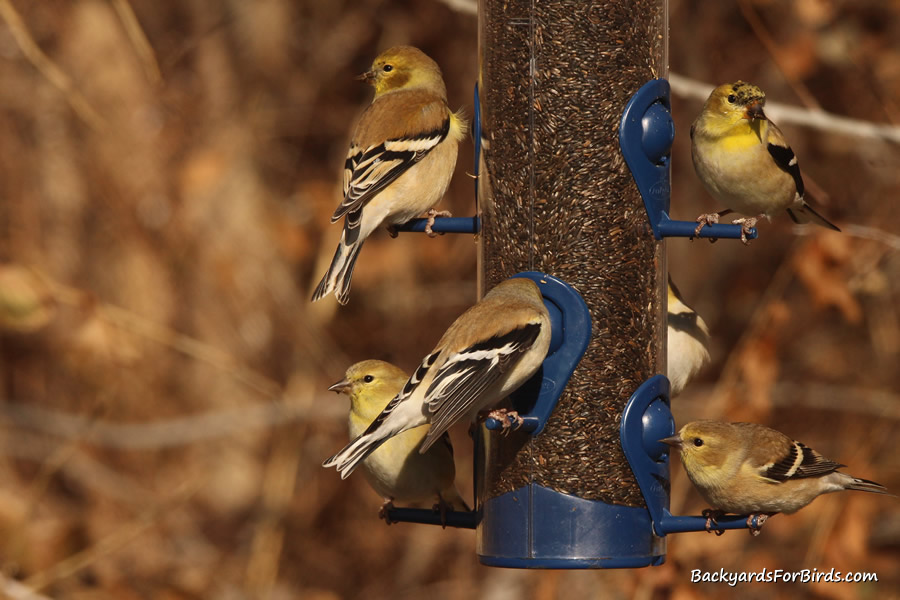Feeding wild birds is a fun and very relaxing hobby.
I have done it for many years now, and I will continue to do it for as long as I am able to get out and fill the bird feeders each day.
There is a large variety of bird feeders available on the market, but how do you choose the right one for the birds you want to attract to your yard?
Not all bird feeders will work equally with all species of birds, so if you are trying to get specific birds to your yard, specific bird feeders, such as a tube feeder, might be the solution for you.
A variety of birds will eat from a tube feeder, such as black-capped chickadees, lesser goldfinches, American goldfinches, house finches, grosbeaks, as well as some species of sparrows.

Goldfinches are what I feed and attract the most in my own yard, and they are the species of birds most commonly attracted to a tube style feeder.
I have rarely seen ground-feeding birds like juncos or spotted towhees, for example, use a tube feeder but it has been known to happen.
Birds that have the instinct to hang while feeding, such as chickadees and goldfinches, are the most common types to come to a tube feeder because it plays on this natural feeding instinct to some degree.
What is a tube feeder?
A tube feeder is a long slim plastic tube with several feeder holes and perches located around the lower portion of the feeder in which songbirds can sit on and pull the feed from within the tube.
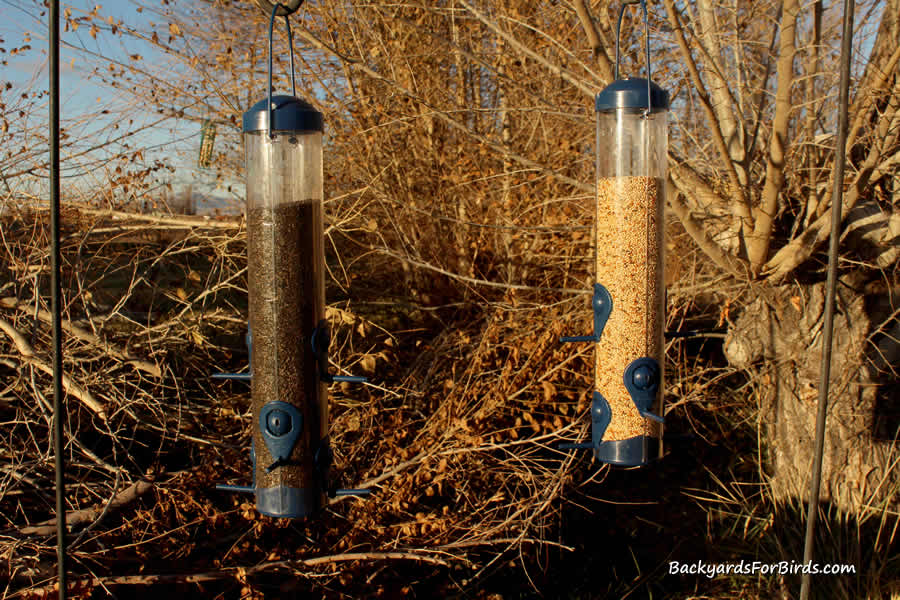
Being made out of plastic, they are lightweight, easy to fill, easy to clean, and are usually fairly inexpensive when compared to many other types of bird feeders that are currently available.
Tube feeders come in a variety of sizes, but most can hold about 4-8 birds on them because of the limited number of perches.
Why use a tube feeder for feeding songbirds?
The advantage of using a tube feeder is you can specifically target and attract some bird species while discouraging others.
Their unique design, including small feeder holes and small, limited perches, will help discourage bigger birds such as jays, grackles, and red-winged blackbirds.

Tube feeders are also fairly inexpensive, and some of them are versatile to where they can handle different types of wild bird food.
Some tube feeders have movable feeder hole coverings that allow you to use a small hole for smaller seeds or a much bigger opening for larger types of seed.
What birdseed works best in a tube feeder?
Depending on the size of the feeder holes your tube feeder has, you can use nyjer seed, millet seed, or blends that even have cracked corn and black oil sunflowers.
Feeders with larger holes can use any type of birdseed available, but as a result, this type of feeding will attract many more and sometimes unwanted species of birds to the feeder.

The house sparrow, a well-known pest and waster of birdseed, is a common bird at many feeders that allow for such feeding.
The house sparrows will flick lots of birdseed to the ground while searching for specific seeds, wasting much bird food in the process.
They can definitely do this on a tube feeder with large feeding ports so keep that in mind when choosing a tube feeder and birdseed to use in it.
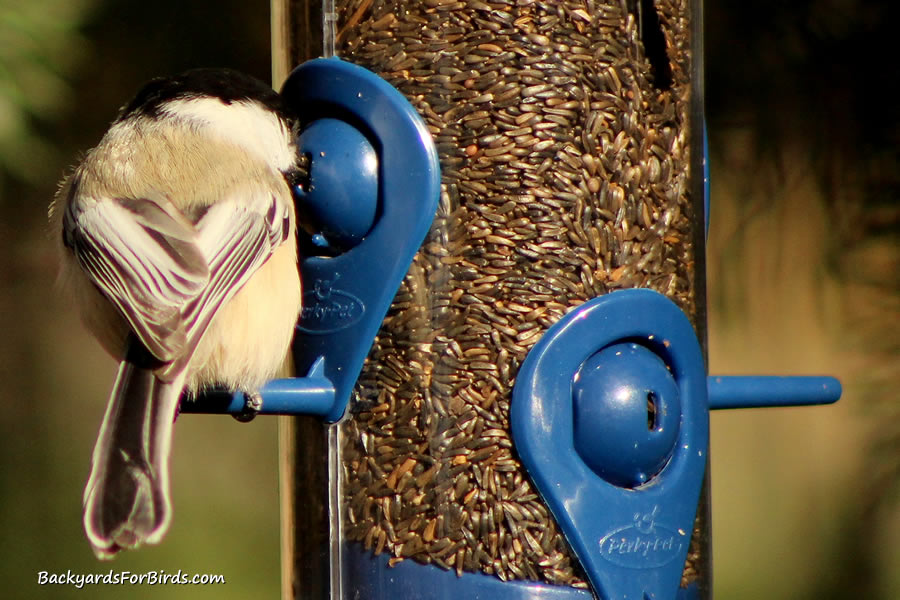
This is why choosing the right tube feeder for specific species of birds is important.
Tube feeders with smaller holes, ones designed for millet and nyjer seed, will discourage the messy house sparrow, and only birds such as goldfinches, house finches, and chickadees will be able to feed on them.
How do I hang a tube feeder?
The easiest and most versatile way to hang a tube feeder is to use a shepherd’s pole.
This long metal pole with a curved hook at the top can be placed anywhere in the yard and can be moved very easily if needed.
It’s a good solution if you want to place your feeder in specific areas where no other options are present.
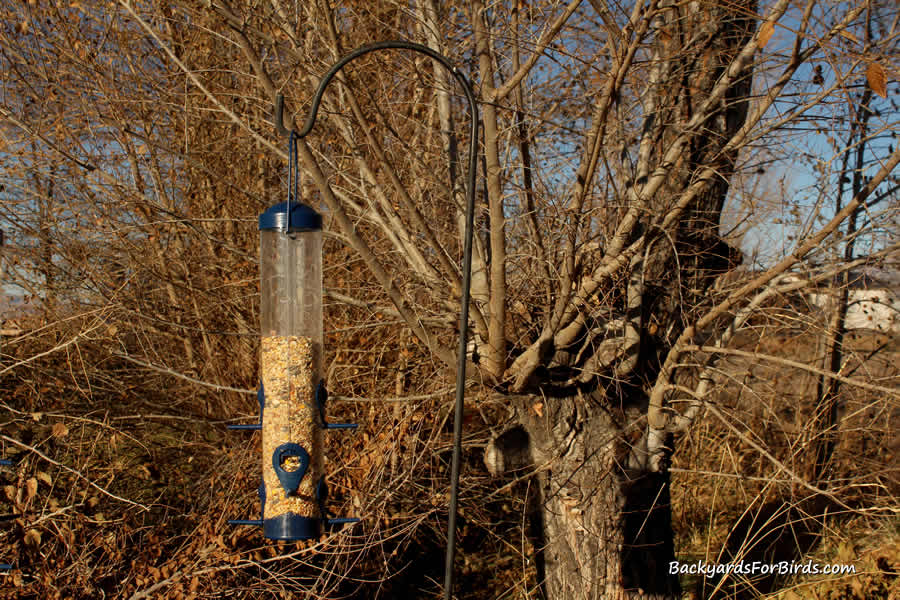
You can also just hang the feeder from a tree branch, as I have done for years.
The disadvantage of this is if you are in an area where squirrels are common, hanging any bird feeder in a tree is inviting squirrels to essentially help themselves to the bird food and, similar to the house sparrow, end up wasting much of it in the process.
A shepherd’s pole will allow you to move the feeder a few feet away from the tree, discouraging squirrels while still having the bird food close enough to the tree so birds can easily find it.
Best place to hang a tube feeder for birds.
Just like all bird feeders, the best place to put a tube feeder is near cover and water. Hang it near a large tree or bush, if you have one. That will help the birds find it more quickly.
If you don’t have any trees or shrubs in your yard, place it near a fence or in an area where your neighbors might have a tree or bush close by.
Anywhere like this, areas, where birds might perch for a bit, is a good place to start.
Where ever your bird feeder is placed, add a simple birdbath nearby. Having water by your bird feeder will help attract more birds to your yard and help attract them more quickly as well.
Perky-Pet 2 in 1 wild bird feeder
The feeder I am currently using in my own yard with great results is the Perky-Pet 2 in 1 Wild Bird Feeder. It is inexpensive, easy to fill, and easy to clean.
The feeding ports have a movable cover which allows you to either feed small seeds, such as nyjer or millet while discouraging house sparrows and blackbirds, or larger feeding ports for bird food such as corn or black oil sunflowers to attract a greater variety of birds.

In my yard, I have 2 of these tube feeders set up, one with nyjer seed and the other with a millet seed mixture.
Both are using the feeding ports with doors closed, and the goldfinches are easily feeding on both feeders.
I was a bit nervous the millet was too big to fit through the feeding hole, but the finches are feeding on it as easily and as quickly as the nyjer seed feeder.
Conclusion
I am an avid bird watcher and have several wild bird feeders in my yard to attract and feed songbirds throughout the year.
Tube feeders are an inexpensive way to attract and feed goldfinches, chickadees, and house finches.
Over the years, I have used a variety of bird feeders and I am still using the simple tube feeder in my yard.
I now look for the ones with the small feeding ports to discourage house sparrows and, surprisingly, I have no sparrow problems with these particular feeders.
Over time, the inexpensive plastic tube feeders will eventually sun-rot and will have to be replaced but I have had several years of use from some of mine so even though they will eventually wear out, the cheap plastic tube feeders are still a great way to go while feeding goldfinches and chickadees.
Subscribe to our blog
Don’t forget to subscribe to our blog for notifications for future blog posts about birds, butterflies, and all the other fascinating creatures we can attract to our very own yards.
Nature is fascinating and even more so when we can observe, learn, and enjoy it anytime we want in our own backyards.
